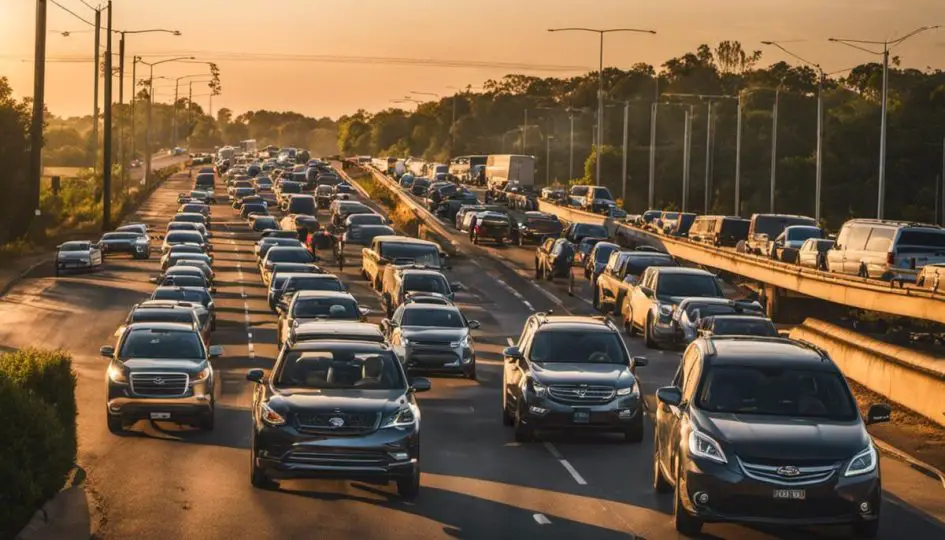Every morning, the otherwise peaceful descent of children into the confines of their schools transforms into a mess of honking, swerving, and slow-moving traffic. The extreme congestion during school drop-offs has evolved into a truly pressing issue with repercussions far beyond simple inconvenience. Not only does this issue disrupt the daily routine of parents, students, and commuters but it also poses broader implications for the community—in terms of safety, productivity, and overall quality of life. We’ll delve into the complexities of traffic delays during school drop-offs, investigating causal factors, existing strategies, and the role that individuals and infrastructure play in this systemic issue. Beyond merely shedding light on the problem, we’ll look to international examples and innovative solutions with the aim of providing feasible recommendations for improvement.
Understanding the Situation
Understanding School Drop-off Traffic Congestion
The phenomenon of traffic congestion during school drop-off hours is ubiquitous across many parts of America. This issue arises primarily as a result of parents transporting their children directly to school settings, all converging towards the same location at similar times to comply with set school hours.
Root Causes of Congestion at School Drop-off Times
There are several significant factors contributing to traffic delays during school drop-offs. This issue predominantly stems from the timing and location of many schools. Since most schools have similar start times, this leads to peak traffic during those morning hours when parents are trying to drop off their children. Additionally, the close proximity of many schools to residential areas and the design of those areas predominantly for low-volume traffic creates hotspots for congestion.
Many schools lack adequate infrastructure to handle the surge in vehicles during drop-off and pick-up times. Limited parking spaces, narrow entrance lanes, and an influx of vehicles often result in long queues and traffic snarls. Weather variants like rain or snow exacerbate the issue further by slowing down the traffic movement.
Effects on Individuals’ Daily Routines
On an individual level, the traffic delays resulting from school drop-offs significantly disrupt people’s daily routines. Often parents need to leave their homes much earlier to account for the potential delay, which might lead to adjustments in morning routines. Moreover, these delays can cause stress and frustration as parents and children alike grapple with the pressure of reaching their respective destinations on time, potentially impacting their psychological wellbeing.
For those using the same routes, such as for commuting to a job, these traffic congestions increase travel time, cause potential tardiness, and even affect gas consumption due to idling in traffic – all of which have implications on daily productivity and resources.
Wider Implications for the Community
Beyond individual impact, traffic delays during school drop-offs have wider implications for the community. First, congestion creates environmental concerns due to increased emissions from idling vehicles, contributing to local air pollution levels. Second, heavy traffic around school zones can be unsafe, particularly for walking or biking students, increasing the risk of traffic accidents. Similarly, emergency vehicles may have difficulty navigating through these congested areas during peak times, potentially imperiling lives in critical situations.
Additionally, the intensified wear and tear on roads due to concentrated traffic volumes can lead to increased maintenance costs for local governments, impacting the collective community budget.
A Path Forward
Addressing the traffic congestion experienced during school drop-offs requires a comprehensive and multipronged strategy. This includes reevaluating current school transportation policies, upgrading and enhancing the infrastructure surrounding schools, implementing staggered times for school commences, and encouraging alternatives to single-family car use like carpooling, walking, or biking. With a focus on alleviating traffic delays linked to school drop-offs, we’re not just improving daily commutes, but also making strides toward environmental sustainability and enhanced safety within the community.

Comparative Analysis
Effective Strategies in US School Drop-off Traffic Remediation
Across the United States, methodologies for managing school drop-off traffic can vary drastically. Factors such as school size and its location play a crucial role in defining these methods. In urban settings, schools often promote the initiative of walking or biking under the “Safe Routes to School” scheme. This program not only aims at reducing traffic congestion but also prioritizes the safety of students. Furthermore, it typically employs crossing guards and designates pedestrian zones to safe-guard students during their commute.
For students who live at distances that rule out walking or cycling, many schools provide bus transportation. This effectively replaces multiple individual cars with one larger vehicle, significantly reducing the traffic during drop-off hours. However, it’s important to point out that inadequate bus capacity and inefficient route planning can sometimes add to traffic delays or overcrowding on buses.
Traffic Management in Suburban or Rural Schools
In suburban or rural settings where public transport or walking isn’t feasible, schools commonly have a ‘car drop-off zone.’ This system provides a smooth flow of traffic where parents are not allowed to park but must keep the vehicle moving. A ‘kiss and go’ policy is often in place where parents should promptly drop off their children before moving along to make space for other vehicles. This requires strict adherence to rules and cooperation, or it may culminate in chaos and heavy traffic.
International Perspectives on School Drop-off Traffic Management
In Japan, school children often walk to school in groups or ‘walking school buses,’ guided by a few adults. This practice not only instills a sense of independence in the children but significantly cuts down on car traffic during peak hours.
Conversely, in the Netherlands and Denmark, cycling is the dominant mode of transport for school-going children. Schools in these countries are equipped with large bicycle parking lots, and designated bike paths make these journeys safer.
Pros and Cons Associated With Various Methods
Methods like ‘Safe Routes to School,’ school buses, and ‘kiss and go’ zones aim to alleviate traffic congestion and enhance safety, thereby encouraging even more parents to let their children walk, cycle, or take the bus. While effective to some extent, they require immense planning, supervision, and community cooperation, which can be challenging to obtain.
On the other hand, practices like the walking school bus or cycling bring numerous benefits such as promoting physical activity and reducing environmental impact. However, they may not be universally applicable, predominantly due to safety concerns, weather conditions, or excessively long commutes.
Navigating solutions for traffic delays during school drop-offs requires considering the unique circumstances in different locations. In some regions, extreme weather may render walking or biking unsuitable for many months of the year. Likewise, in high-density urban settings, with limited school bus services or far-reaching school choice policies, students may have to travel considerable distances to attend their chosen school. This makes the conventional drop-off systems less effective. Thus, each proposed solution comes with its unique set of challenges that need to be evaluated within its specific context.

Role of School Policies and Infrastructure
Moving forward, it’s important to also look at how existing school policies are contributing to traffic delays in school drop-offs. Many school authorities have put in place specific regulations dictating the locations and timing for parents to drop-off their children, tailored around ensuring pupil safety. However, these regulations may unintentionally spur road traffic congestion, especially when many vehicles are directed towards a limited area. For instance, some policies may enforce a single drop-off point which inevitably leads to a logjam, or disallow early drop-offs that otherwise would have helped in distributing traffic more evenly.
School Design and Traffic Congestion
The design and infrastructure of schools also play a significant role in traffic congestion. In older schools, for instance, infrastructure wasn’t designed to accommodate the high volume of vehicles we see today. Tight, narrow driveways and small drop-off zones can cause traffic pile-ups, with vehicles idling as they wait to reach the drop-off point. Moreover, the lack of separate zones for buses and private vehicles often leads to more confusion and bottlenecks.
The Role of School Staff in Drop-Off Traffic Delays
School staff have an essential role in managing drop-off and pick-up times as their organization, supervision, and intervention can significantly impact traffic flow. Efficient coordination can alleviate congestion, while poor management can exacerbate the problem. When staff adequately direct traffic and enforce drop-off and pick-up rules, they can prevent cars from idling longer than necessary and keep the traffic moving.
Parent Behavior and Traffic Delays
Parent behavior during school drop-offs contributes greatly to traffic congestion. Parents who linger during drop-offs, stop their cars in the middle of traffic to say goodbye, or don’t follow the school’s drop-off procedures can cause the traffic flow to slow or even halt, backing up cars and causing delays.
Revisiting Rules and Infrastructure to Tackle Congestion
There is a clear need to revisit existing rules and infrastructure to address the issue of traffic delays during school drop-offs. Schools might consider reviewing their drop-off policies to spread traffic volume more evenly. This could be as simple as staggering start times or designating multiple drop-off points.
The school’s existing infrastructure may also need enhancement or redesign to accommodate today’s traffic volumes. Wider driveways, larger drop-off zones, separate spaces for buses and cars, and better thought-through circulation patterns can solve many current traffic issues.
Better training of school staff for traffic control and rigorous enforcement of drop-off and pick-up protocols can help streamline traffic flow. Lastly, clear communication with parents about the rules and the importance of following them promptly can instill better behaviors and cooperation.
Addressing traffic delays during school drop-offs requires an approach that considers all relevant factors and stakeholders involved in the situation.

Possible Solutions and Their Implementation
An Examination of School Drop-off Traffic Delays
School drop-off and pick-up periods are notorious for causing traffic delays across various cities and towns. These halts can be attributed to factors such as improper drop-off and pick-up strategies, an overwhelming number of personal vehicles operating simultaneously, and poor infrastructure. To address this congestion and ensure a smoother traffic flow, a combination of solutions might be necessary. These could range from altering the existing rules, improving the infrastructure, to incorporating innovative tech-based solutions.
Potential Policy Changes
One of the ways to address school traffic congestion is through policy changes that encourage parents and guardians to consider alternatives to single-vehicle trips. Implementing carpool systems or school bus services can significantly reduce the number of cars on the road. Also, schools and local jurisdictions can offer incentives to families who utilize these options, thus promoting use. Policies promoting walking, biking, or public transportation, especially for families living close to schools, could be another effective approach. In implementing these policies, considerations must be made for the safety and security of children, especially those walking or biking to school.
Infrastructure Modifications
Improving the infrastructure surrounding schools can also play a crucial role in reducing traffic delays. Creating separate drop-off and pick-up lanes, widening roads, and adding more entrances and exits can help expedite the process. Additionally, better signage can guide drivers to use appropriate lanes and follow protocols, therefore, minimizing confusion and reducing delay times. Schools can also consider constructing off-site drop-off or pickup locations that allow for a smooth flow of traffic. These modifications, however, require substantial funding and planning and may take time to materialize.
Innovative Technological Solutions
In the digital age, technology offers innovative solutions to mitigate traffic delays during school drop-offs. With advanced software systems and mobile apps, schools can streamline the drop-off and pick-up process. These apps can enable parents to register their arrival digitally, thereby reducing unnecessary waiting periods. They can also keep parents informed about traffic situations in real-time, allowing them to plan their schedules accordingly. Automatic number plate recognition (ANPR) systems can also be employed to reduce congestion. These systems can identify and allow only authorized vehicles into the drop-off/pick-up zone, thereby ensuring a hassle-free process.
Practical Implementation Challenges
The suggested measures to mitigate traffic delays, while promising, rely heavily on several crucial factors. Issues such as financial limitations, community buy-in, safety, and enforceability have to be thoroughly addressed. For any policy changes to yield successful outcomes, ongoing and rigorous enforcement must be in place, which mandates the teamwork of parents and the local police. Moreover, infrastructural transformations call for substantial financial and strategic investment. Equally, the application of technology-based solutions demands dependable internet access and adequate tech-savvy users. Hence, the fruition of these initiatives demands meticulous strategizing, priority setting, and the collective efforts of various stakeholders comprising schools, parents, local authorities, and community members.

Parent and Community Involvement
Analyzing the Problem: Congestion During School Drop-offs
The predicament of traffic delays during school drop-offs is a nationwide issue that extends beyond just a commuting nuisance. This challenge creates potential hazards for the school community, particularly children, along with contributing to environmental pollution and inefficiency of time. The key to resolve this issue rests in the shared contribution of parents, school authorities, and the broader community.
The Role of Parents
Parents play a critical role in managing traffic delays during school drop-offs. Following designated drop-off procedures is fundamental. These protocols typically dictate where and when students can be dropped off, so as to minimize congestion and maintain a steady flow of traffic. Adhering to these guidelines reduces driver frustration, improves safety, allows children to arrive on time, and makes the drop-off experience more convenient for everyone involved.
Another effective strategy that parents can implement is forming car pools. Carpooling reduces the number of vehicles driving to and from the school, thereby decreasing traffic departure delays and congestion. Furthermore, it aids in reducing harmful emissions, contributing to the community’s overall environmental efforts.
Community-Led Initiatives
The wider community can impact the traffic situation during school drop-offs through community-led initiatives. A popular initiative is the “walking school bus,” a group of children walking to school with one or more adults in a structured manner. This concept not only cuts down on car usage, hence reducing traffic congestion, but also promotes healthy habits and community bonding among children and adults alike.
Local businesses can also be engaged to aid in alleviating traffic congestion. For instance, shops located close to schools might allow their parking lots to be used as drop-off points or carpool gathering areas before and after school hours.
School Administration Efforts
School administrations can collaborate with local government bodies or transportation experts to develop more effective drop-off and pick-up routines. They can negotiate staggered school times with local education authorities to prevent traffic peaks, strategize better parking layout designs, or implement reroutes to increase road capacity around the school area.
The Role of Local Government
Municipal or local government can have a significant influence on easing traffic delays during school drop-offs. City planning can integrate safer pedestrian pathways, more efficient road designs, and increased signage for school zones. Law enforcement can also contribute by ensuring that traffic laws and school drop-off and pick-up procedures are adhered to consistently.
In conclusion
solving the issue of traffic delays during school drop-offs is not the responsibility of a single stakeholder. It’s an effort that requires the cooperation of parents, school administrations, local government, and the wider community. By synchronizing efforts, communities can ensure safer and less congested routes, contributing to a more productive, environmentally-conscious society.

Regardless of the scope of these proposed solutions, the road to meaningful change requires every stakeholder’s active participation, including parents, school staff, local authorities, and community members. Parents can take simple but significant steps such as obeying drop-off procedures, planning their travel well ahead of time, or considering carpool initiatives. Schools and local authorities, on the other hand, need to regularly review and improve infrastructure and policies for more efficient traffic management. Meanwhile, the broader community can foster change through awareness campaigns and community-led efforts to curb the traffic delays during school drop-offs. As a collective effort, managing this issue requires acknowledging the concern, understanding its complexity, and acting responsibly for the betterment of our community and our children’s futures.


Recent Comments